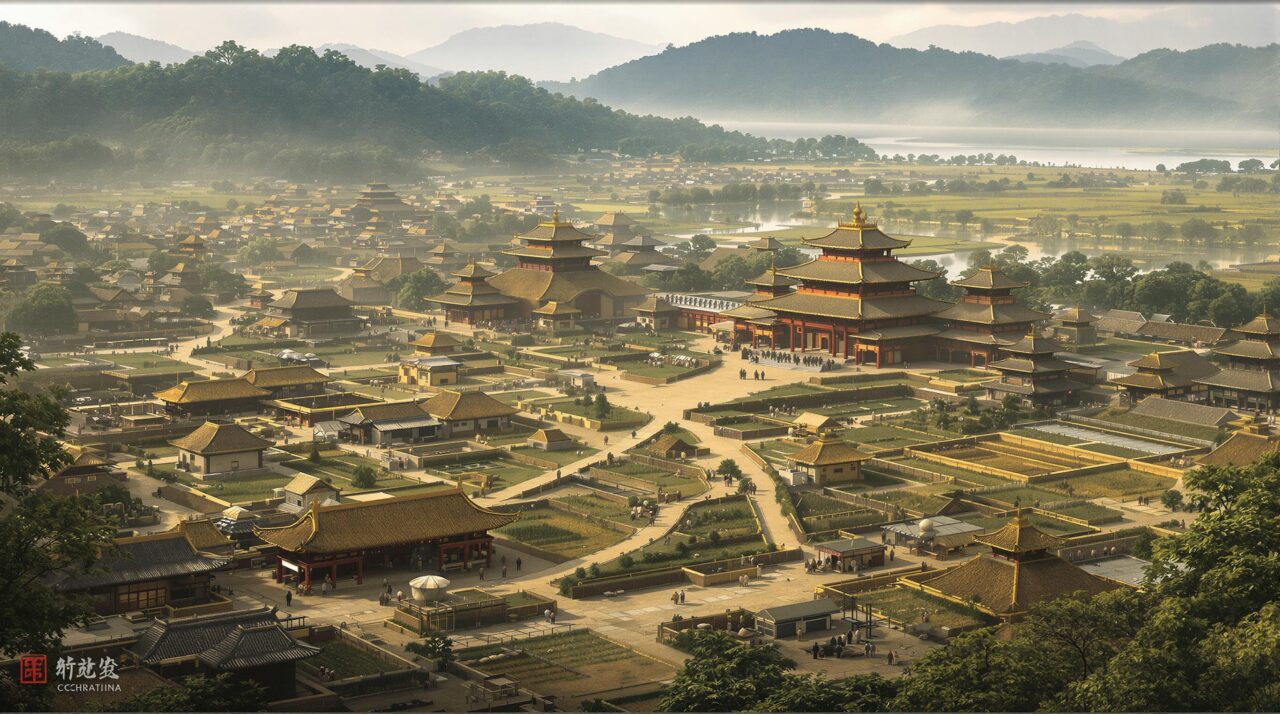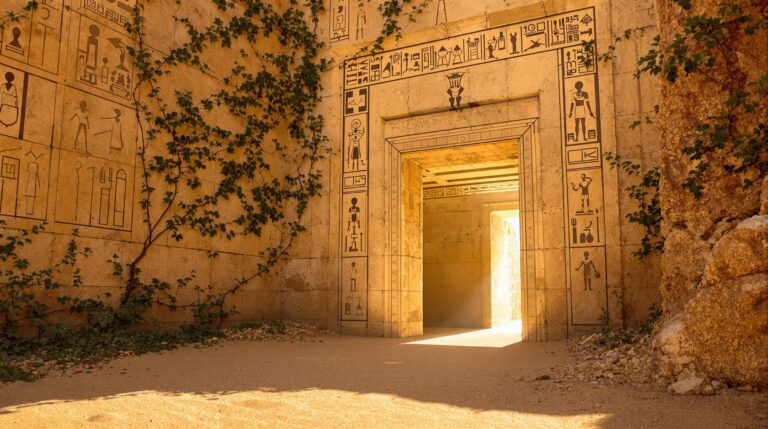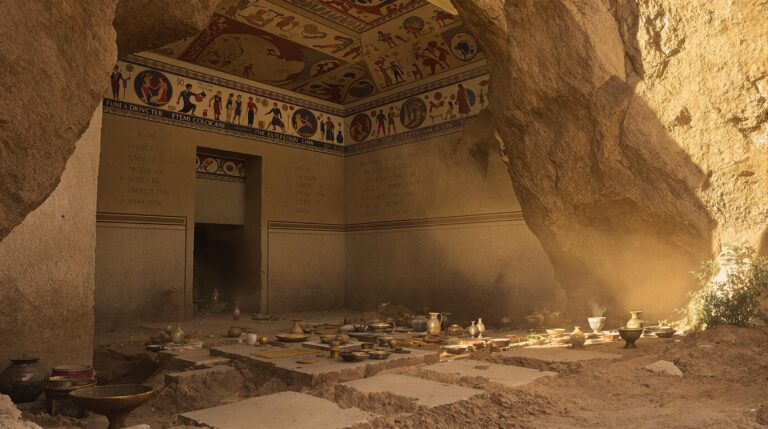Ancient China: The Xia Dynasty

The Xia Dynasty represents a pivotal moment in ancient China’s evolution. Shifting from nomadic tribes to a structured agrarian society, it established the foundations of governance and social organization.
Yu the Great‘s innovations in flood control not only safeguarded crops but also highlighted the dynasty’s technological advancements.
The interplay of myth and history surrounding this era raises questions about its true nature. What mysteries lie within its legacy, waiting to be uncovered?
Key Takeaways
Hide- The Xia Dynasty is considered the first dynasty of ancient China, emerging from agrarian societies and tribal unification under Yu the Great.
- Yu the Great's flood control methods and agricultural innovations laid the foundation for societal organization and governance in early China.
- The dynasty's political structure featured hereditary rulers supported by regional lords, blending local autonomy with central authority.
- Ancestor worship and religious practices were integral to Xia society, reinforcing social order and cultural identity despite the lack of written records.
- The legacy of the Xia Dynasty influenced later Chinese philosophies, shaping notions of governance, morality, and national identity throughout history.
The Origins of the Xia Dynasty in the Ancient China

The origins of the Xia Dynasty can be traced back to early settlements where the emergence of tribal leaders marked the change from nomadic to agrarian societies.
This shift facilitated the development of flood control systems, which not only sustained agriculture but also laid the groundwork for centralized governance.
As these leaders consolidated power, they transformed local communities into a cohesive political entity, ultimately leading to the establishment of the Xia Dynasty as a formative influence in Chinese history.
Early Settlements and the Rise of Tribal Leaders
The origins of the Xia Dynasty can be traced back to Neolithic settlements, particularly those influenced by the Longshan culture, which laid the groundwork for complex societal structures.
As communities began to coalesce, the emergence of figures like Yu the Great marked a pivotal moment in unifying disparate tribal factions under a centralized leadership.
This transformation not only shaped the political landscape but also set the stage for the development of early Chinese civilization.
Neolithic roots and the Longshan culture
Neolithic roots in China reveal a complex tapestry of early human settlements and cultural developments, particularly through the lens of the Longshan culture.
This period, characterized by advanced pottery and social stratification, laid the groundwork for emerging leadership structures.
The Longshan culture’s innovations in agriculture and technology not only enhanced local economies but also fostered the conditions for the eventual rise of organized governance.
The emergence of Yu the Great as a unifying figure
Emerging from the backdrop of early settlements in ancient China, Yu the Great stands as a pivotal figure in the formation of the Xia Dynasty.
His unparalleled ability to unite disparate tribes through leadership and innovative flood control methods not only fostered agricultural prosperity but also laid the groundwork for a cohesive identity.
Yu’s legacy transcended mere governance, embodying the aspirations of a burgeoning civilization.
From Flood Control to Founding Rule
The origins of the Xia Dynasty are intricately linked to the legendary efforts of controlling the unpredictable Yellow River, a feat that underscored the necessity of organized governance.
This monumental achievement not only showcased early engineering prowess but also laid the groundwork for establishing hereditary rule, marking a significant shift in political structure.
As the Xia emerged from the chaos of natural disasters and tribal leadership, the foundation for dynastic succession was solidified, setting a precedent for future Chinese states.
The legendary taming of the Yellow River
In the annals of Chinese history, the legend of the Yellow River’s taming stands as a pivotal narrative that underscores the emergence of the Xia Dynasty.
This tale illustrates humanity’s struggle against nature’s fury, symbolizing resilience and ingenuity.
Through the legendary figure of Yu the Great, the narrative emphasizes the importance of leadership and collective effort in overcoming adversity, shaping the societal foundation of ancient China.
Establishing hereditary rule and the start of dynastic succession
Establishing hereditary rule marked a significant turning point in the evolution of the Xia Dynasty, transforming governance from collective leadership to a structured dynastic system.
This shift not only solidified power within familial lines but also fostered stability and continuity. As rulers passed authority to their descendants, the principles of loyalty and legacy emerged, shaping the sociopolitical landscape of ancient China and influencing future dynasties.
Structure of Xia Society
The structure of Xia society reveals a complex interplay between political organization and daily life, underscored by the early kingship that sought to unify various tribes.
Agricultural practices not only sustained the population but also reflected the social hierarchy, as land management became a critical aspect of governance.
Understanding these elements provides insight into how the Xia Dynasty laid the groundwork for subsequent Chinese civilizations.
Political Organization and Early Kingship
The political organization of the Xia Dynasty was characterized by a lineage of rulers who established central authority while simultaneously delegating power to regional lords.
This dual structure facilitated local governance, allowing lords to maintain order and resources within their jurisdictions.
Examining this balance reveals insights into how early kingship influenced societal stability and the complexities of governance in ancient China.
Lineage of Xia rulers and central authority
While the precise origins of the Xia Dynasty remain shrouded in the mists of legend, its lineage of rulers illustrates a foundational shift towards centralized authority in early Chinese civilization.
The succession of kings established a model of governance that emphasized hereditary rule, intertwining legitimacy with dynastic continuity.
This evolving political structure laid the groundwork for future centralized states, influencing societal cohesion and stability.
The role of regional lords and local governance
Regional lords played a crucial role in the governance structure of the Xia Dynasty, serving as both local rulers and essential links between the central authority and the populace.
Their influence enabled localized decision-making, fostering a sense of autonomy while maintaining loyalty to the central power.
This duality highlighted the complexities of early kingship, balancing regional interests with overarching unity, necessary for societal cohesion.
Daily Life and Agricultural Practices
The daily life of the Xia Dynasty was intricately linked to its agricultural practices, which were shaped by innovative tools and a variety of crops cultivated by early farmers.
The housing and clothing of this society reflected not only their agricultural successes but also their craftsmanship and communal values.
Tools, crops, and farming innovations
As agricultural practices flourished during the Xia Dynasty, innovations in tools and crop cultivation played a pivotal role in shaping daily life and the societal structure of ancient China.
The introduction of plows and irrigation techniques greatly enhanced productivity, allowing communities to cultivate rice and millet more efficiently.
Such advancements not only increased food security but also fostered social organization and economic development, empowering individuals within the society.
Housing, clothing, and crafts in early Chinese settlements
Housing, clothing, and crafts in early Chinese settlements reveal significant insights into the social fabric and cultural practices of the Xia Dynasty.
The architecture, often constructed from readily available materials, reflected communal living and adaptability.
Clothing styles, varying by status and function, illustrated individual identity.
Meanwhile, crafts showcased not only artistic expression but also the technological advancements that underpinned daily life, fostering a sense of community and resilience.
Technological and Cultural Developments
The Xia Dynasty marked a significant period of technological and cultural advancements, particularly through the introduction of early bronze use and refined pottery craftsmanship.
These innovations not only enhanced daily life but also reflected the society’s evolving aesthetic sensibilities and practical needs.
Additionally, the intertwining of religious beliefs and ancestor worship played an essential role in shaping the spiritual and social fabric of the time, influencing both artistic expression and communal identity.
Early Bronze Use and Pottery Craftsmanship
The Xia Dynasty marked a significant shift in technological advancements, particularly through the early use of bronze for tools and weapons, which enhanced agricultural and military capabilities.
Concurrently, the emergence of distinct pottery designs reflected not only artistic expression but also the cultural identity of the era.
These developments in metallurgy and ceramic craftsmanship underscored a complex interplay between innovation and societal evolution during one of China’s foundational dynasties.
Tools and weapons during the Xia period
During the Xia Dynasty, a significant shift in technological and cultural practices marked the emergence of early bronze use and advanced pottery craftsmanship.
Tools and weapons, crafted from bronze and stone, enabled improved agriculture and warfare.
These innovations not only enhanced productivity but also reflected the society’s evolving complexity, as they signified a burgeoning understanding of material properties and skilled labor within a dynamic cultural framework.
Distinct pottery designs and ceramic advancements
With the advent of bronze tools and weapons, the Xia Dynasty also witnessed a remarkable evolution in pottery design and ceramic technology.
Artisans began to employ innovative techniques, creating intricate patterns and diverse forms that reflected both utility and aesthetic values.
This advancement in craftsmanship not only enhanced everyday life but also served as a medium for cultural expression, symbolizing the dynamic spirit of early Chinese society.
Religious Beliefs and Ancestor Worship
The religious landscape of the Xia Dynasty was profoundly shaped by rituals, divination practices, and the influential role of shamans, illustrating a complex interaction between spirituality and governance.
Symbols of power, often manifested in sacred items found in burial sites, highlight the significance of ancestor worship as a means of maintaining social order and continuity.
This intertwining of belief systems with technological and cultural advancements offers a compelling lens through which to understand the dynamics of early Chinese civilization.
Rituals, divination, and the role of shamans
Rituals, divination, and the pivotal role of shamans in the Xia Dynasty illustrate a complex interplay between spirituality and governance in ancient China.
Shamans acted as intermediaries between the spiritual and earthly domains, employing divination techniques to guide decisions and guarantee societal harmony.
These practices not only reinforced the authority of rulers but also fostered a collective identity, intertwining faith with the fabric of everyday life.
Symbols of power and sacred items in burials
Burial practices in the Xia Dynasty revealed profound insights into the society’s symbols of power and its deep-seated beliefs in ancestor worship.
Elaborate grave goods, such as bronze vessels and jade artifacts, served not only as status markers but also illustrated the connection between the living and the dead.
These sacred items reflected a reverence for ancestry, ensuring continuity and influence beyond death.
Myth, History, and Archaeology
The historical existence of the Xia Dynasty has long been a subject of debate, intertwining myth and archaeological evidence.
Researchers examine the Erlitou culture, often considered a potential link to the Xia, to discern its significance in the broader narrative of Chinese history.
This inquiry raises critical questions about how mythology informs historical understanding and the role that archaeology plays in substantiating or challenging traditional accounts.
Debating the Xia’s Historical Reality
The historical existence of the Xia Dynasty remains a contentious topic, underscored by the absence of contemporary written records.
Scholars grapple with contrasting mythological narratives and archaeological findings that both support and challenge the dynasty’s authenticity.
This intersection of myth and material culture invites a critical examination of how history is constructed and understood in ancient contexts.
Lack of contemporary written records
Contemporary written records from the Xia Dynasty remain elusive, creating a contentious debate among historians and archaeologists regarding its historical reality.
This absence of documentation raises questions about the intersection of myth and fact, leaving scholars to navigate a landscape rich in oral traditions yet sparse in tangible evidence.
The challenge lies in reconciling these narratives to discern the true legacy of this enigmatic dynasty.
Contrasting mythological texts with archaeological evidence
Amidst the ambiguity surrounding the Xia Dynasty’s historical existence, the interplay between mythological narratives and archaeological findings offers a compelling framework for understanding this ancient era.
While myths often embellish the past, archaeological evidence provides tangible links to historical realities.
This contrast invites scholars to reconsider the Xia’s legacy, blending storytelling with empirical inquiry to illuminate an enigmatic chapter of early Chinese civilization.
Erlitou Culture and the Xia Connection
The discoveries at Erlitou have sparked considerable debate regarding their implications for understanding the Xia Dynasty.
The site’s sophisticated urban planning, characterized by distinct palace layouts and an array of bronze artifacts, suggests a complex society that may align with the legendary accounts of the Xia.
As scholars explore these connections, the interplay between myth and archaeology continues to challenge conventional narratives of early Chinese civilization.
Discoveries at Erlitou and their significance
Erlitou, a site that has garnered significant attention in archaeological circles, presents a compelling intersection of myth, history, and material culture, particularly in relation to the enigmatic Xia Dynasty.
Discoveries at this location, including architectural remains and artifacts, challenge traditional narratives. They invite scholars to reevaluate the historical authenticity of the Xia, illuminating connections between legend and early Chinese civilization’s developmental phases.
Layout of palaces, bronze artifacts, and urban planning
Archaeological investigations at Erlitou reveal a sophisticated urban layout, characterized by the arrangement of palatial structures and evidence of advanced urban planning.
This complex design signifies a high level of societal organization and cultural sophistication.
- Strategically located palaces
- Intricate bronze artifacts
- Well-structured residential areas
- Evidence of ceremonial spaces
Such elements underscore the Xia Dynasty’s influence on subsequent Chinese civilization, fostering a legacy of innovation and governance.
Legacy and Influence on Later Dynasties
The Xia Dynasty’s ideals greatly shaped the philosophical landscape of subsequent dynasties, particularly influencing Zhou and Confucian thought.
By transforming myth into a cornerstone of national identity, the Xia established a narrative that resonated through centuries, embedding principles of governance and morality into the collective consciousness.
This legacy not only legitimized later rulers but also fostered a cultural continuity that defined Chinese civilization.
Xia Ideals in Zhou and Confucian Thought
The ideals of the Xia Dynasty greatly influenced subsequent Chinese thought, particularly through the lens of Zhou and Confucian philosophies.
Central to this discourse is the concept of the Mandate of Heaven, which emerged as a framework for legitimizing rulers and reflecting moral governance, rooted in the lessons learned from the Xia’s eventual decline.
This legacy not only shaped political ideologies but also underscored the importance of ethical leadership, setting a precedent for later dynasties.
The concept of the Mandate of Heaven
Governance in ancient China was profoundly shaped by the concept of the Mandate of Heaven, a philosophical framework that emerged during the Xia Dynasty and evolved into a foundational principle for subsequent dynasties.
This ideology emphasized:
- The divine right of rulers
- The reciprocal responsibilities between leaders and the governed
- The justification for rebellion
- The moral obligation of rulers to promote harmony
These ideals deeply influenced Zhou and Confucian thought.
Moral lessons drawn from the Xia’s decline
Reflecting on the decline of the Xia Dynasty offers profound moral lessons that shaped the philosophical landscape of subsequent Chinese thought.
Central to this reflection are ideals of governance, virtue, and the consequences of tyranny.
The Zhou’s emphasis on moral leadership and Confucianism’s advocacy for ethical rulers stemmed from the Xia’s failures, underscoring the importance of responsibility and integrity in maintaining societal harmony and legitimacy.
From Legend to National Identity
The Xia Dynasty occupies a unique position in traditional Chinese historiography, often straddling the line between myth and history.
As a symbol of early civilization, its legacy has profoundly influenced national identity, shaping cultural narratives and ideals in modern China.
This intertwining of legend and historical significance invites reflection on how the Xia’s portrayal continues to resonate through subsequent dynasties and contemporary society.
Xia in traditional Chinese historiography
In the tapestry of Chinese historiography, the Xia Dynasty emerges not merely as a historical footnote but as a foundational legend that shaped the nation’s identity.
- Established a narrative of continuity in Chinese civilization
- Fostered a sense of legitimacy for subsequent dynasties
- Influenced cultural values and governance models
- Provided a framework for understanding China’s ancient past
Cultural symbolism in modern China
Cultural symbolism in modern China draws heavily from the legacy of the Xia Dynasty, intertwining ancient narratives with contemporary national identity.
This intricate fabric reflects themes of unity, resilience, and cultural continuity, fostering a sense of belonging among citizens.
As modern China navigates globalization, these symbols serve as anchors, reminding individuals of their historical roots while inspiring aspirations for a progressive future.
Wrapping Up
The Xia Dynasty, a beacon of early civilization, laid the groundwork for future dynasties through its innovative governance and agricultural advancements.
Like the roots of a great tree, its influence permeated the fabric of Chinese society, intertwining culture and morality in a complex tapestry.
As the first to navigate the waters of hereditary rule, the Xia not only shaped their era but also cast a long shadow over the dynasties that followed, echoing through the corridors of history.





